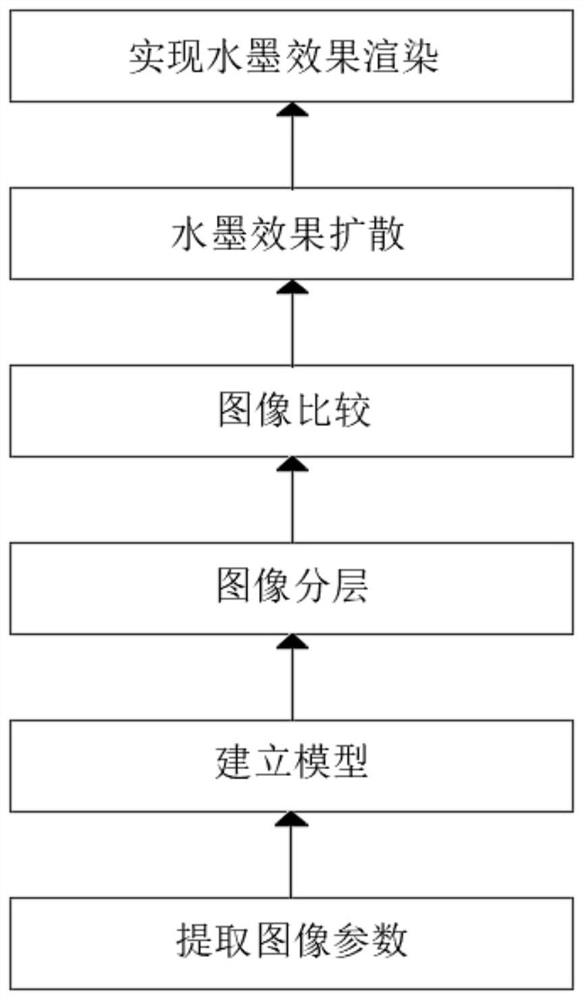Method for realizing ink effect rendering based on neural network graphic algorithm
A graphic algorithm and neural network technology, applied in biological neural network models, neural architecture, 3D image processing, etc., can solve the problems of singleness, inconvenient comparison of difference values, inconvenient background image combination, etc., to achieve convenient display and practicality Good performance and improved accuracy
- Summary
- Abstract
- Description
- Claims
- Application Information
AI Technical Summary
Problems solved by technology
Method used
Image
Examples
Embodiment 1
[0030] A method for realizing ink effect rendering based on a neural network graphics algorithm, comprising the following steps:
[0031] Step 1: Extracting image parameters, extracting and sampling the main lines of the original object in the ink image, the brightness of the color, the characteristics of the texture and the parameters of the pixels;
[0032] Step 2: Build a model, and model the main lines, color brightness, texture and pixel parameters in the ink image extracted in step 1;
[0033] Step 3: Image layering, using convolutional neural network to perform image layering on ink images;
[0034] Step 4: Image comparison, select an appropriate convolutional neural layer and add it to the model in step 2, and compare the difference between the output image and the input image;
[0035] Step 5: Diffusion of ink and wash effects. The main lines, color brightness and texture features of the original object are used as input, and the ink and wash effects are diffused to ...
Embodiment 2
[0049]A method for realizing ink effect rendering based on a neural network graphics algorithm, comprising the following steps:
[0050] Step 1: Extracting image parameters, extracting and sampling the main lines of the original object in the ink image, the brightness of the color, the characteristics of the texture and the parameters of the pixels;
[0051] Step 2: Build a model, and model the main lines, color brightness, texture and pixel parameters in the ink image extracted in step 1;
[0052] Step 3: Image layering, using convolutional neural network to perform image layering on ink images;
[0053] Step 4: Image comparison, select an appropriate convolutional neural layer and add it to the model in step 2, and compare the difference between the output image and the input image;
[0054] Step 5: Diffusion of ink and wash effects. The main lines, color brightness and texture features of the original object are used as input, and the ink and wash effects are diffused to t...
Embodiment 3
[0067] A method for realizing ink effect rendering based on a neural network graphics algorithm, comprising the following steps:
[0068] Step 1: Extracting image parameters, extracting and sampling the main lines of the original object in the ink image, the brightness of the color, the characteristics of the texture and the parameters of the pixels;
[0069] Step 2: Build a model, and model the main lines, color brightness, texture and pixel parameters in the ink image extracted in step 1;
[0070] Step 3: Image layering, using convolutional neural network to perform image layering on ink images;
[0071] Step 4: Image comparison, select an appropriate convolutional neural layer and add it to the model in step 2, and compare the difference between the output image and the input image;
[0072] Step 5: Diffusion of ink and wash effects. The main lines, color brightness and texture features of the original object are used as input, and the ink and wash effects are diffused to ...
PUM
 Login to View More
Login to View More Abstract
Description
Claims
Application Information
 Login to View More
Login to View More - R&D
- Intellectual Property
- Life Sciences
- Materials
- Tech Scout
- Unparalleled Data Quality
- Higher Quality Content
- 60% Fewer Hallucinations
Browse by: Latest US Patents, China's latest patents, Technical Efficacy Thesaurus, Application Domain, Technology Topic, Popular Technical Reports.
© 2025 PatSnap. All rights reserved.Legal|Privacy policy|Modern Slavery Act Transparency Statement|Sitemap|About US| Contact US: help@patsnap.com



